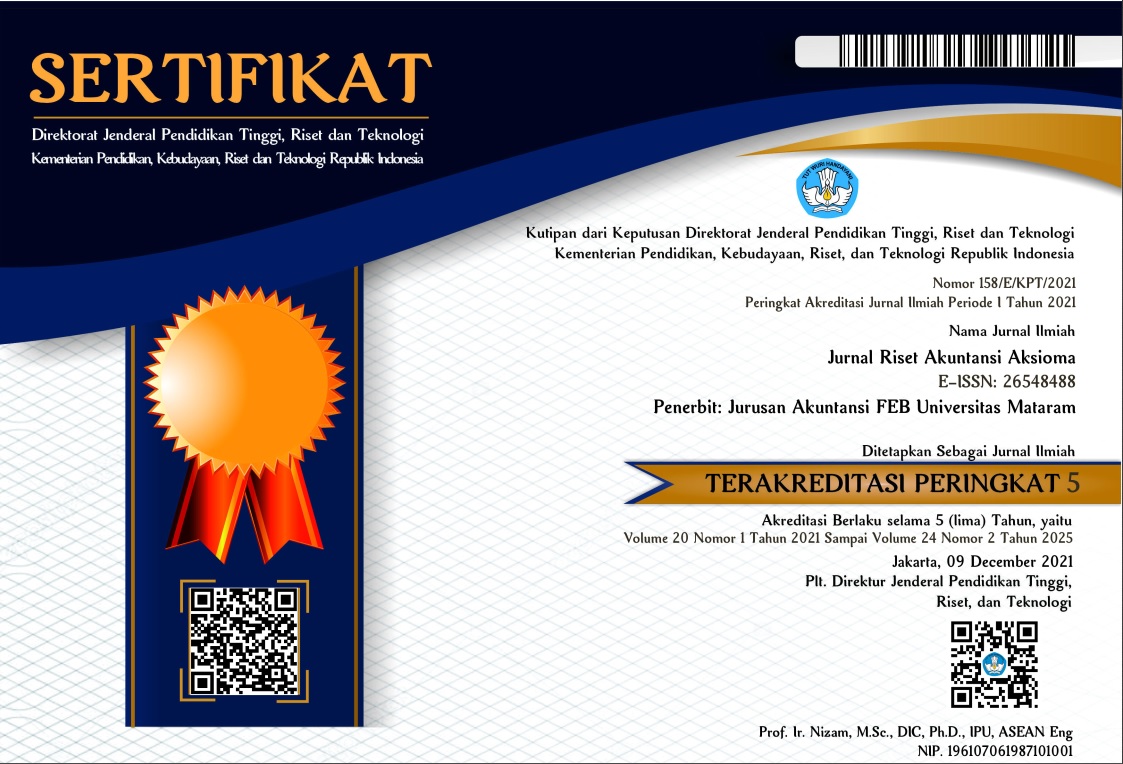PENGARUH FAKTOR KEUANGAN TERHADAP KEPUTUSAN PELAPORAN KEUANGAN DAN PELAPORAN PAJAK
Wahidatul Husnaini., Susi Retna Cahyaningtyas., Lukman Effendy
Abstract
This study emphasizes on one of the management strategies, by accessing whether a company would have a propensity toward the financial reporting or tax reporting. In addition, the study also aims to examine the various factors of corporate finance activities as a source of differences in weighing the financial reporting or tax reporting. These variables are short-term debt, long-term debt, cash deficits and the ability to access capital markets. This study focused on manufacturing companies listed in Indonesia Stock Exchange during 2012 - 2014. Sample was determined based on the purposive sampling method and as a result, this study obtained 66 units of observations. Hypothesis testing based on logit regression showed that (1) 51.5% of companies choose financial reporting above tax reporting while 48.5% chose tax reporting above financial reporting. (2) Long-term debt has negative influence on decisions of financial reporting or tax reporting. Companies with high long-term ratio tend to make aggressive tax reporting for interest expense is deductible expense. (3) Three independent variables such as short-term debt, financing deficit and access to capital markets has no influence the decision of financial reporting or tax reporting.
Keywords: short-term debt, long-term debt, financing deficit, access to capital markets, reporting decision.
References
Atwood, T., Drake, M., Myers, J. and Myers, L. 2012, “Home country tax system characteristics and corporate tax avoidance: international evidence”, The Accounting Review, Vol. 87 No. 6, pp. 1831-1860.
Baker, M. and Wurgler, J. 2002, “Market timing and capital structure”, Journal of Finance, Vol. 57 No. 1, pp. 1-32.
Becker, C., DeFond, M., Jiambalvo, J. and Subramanyam, K. 1998, “The effect of audit quality on earnings management”, Contemporary Accounting Research, Vol. 15 No. 1, pp. 4-24.
Beneish, M. 2001, “Earnings management: a perspective”, Managerial Finance, Vol. 27 No. 12, pp. 3-17.
Chen, L. and Zhao, X. 2000, “On the relation between the market-to-book ratio, growth opportunity, and leverage ratio”, Financial Research Letters, Vol. 3 No. 4, pp. 253-266.
Collins, J. and Shackelford, D. 1992, “Foreign tax credit limitations and preferred stock issuances”, Journal of Accounting Research, Vol. 30, pp. 103-124.
DeAngelo, H. and Masulis, R.W. 1980, “Optimal capital structure under corporate and personal taxation”, Journal of Financial Economics, Vol. 8 No. 1, pp. 3-29.
Desai, M. 2002, “The divergence between book and tax income”, Tax Policy and the Economy, Vol. 17 No. 1, pp. 169-206.
DeFond, M.L. and Jiambalvo, J. 1994, “Debt covenant violation and manipulation of accruals”, Journal of Accounting and Economics, Vol. 17 Nos 1-2, pp. 145-176
Dhaliwal, D., Trezevant, R. and Wang, S. 1992, “Taxes, investment-related tax shields and capital structure”, Journal of American Taxation Association, Vol. 14 No. 1, pp. 1-21.
Diamond, D. W. 1991, “Debt maturity structure and liquidity risk”, Quarterly Journal of Economics, Vol. 106 No. 3, pp. 709-738.
Duke, J.C. and Hunt, H.G. 1990, “An empirical examination of debt covenant restrictions and accounting-related debt proxies”, Journal of Accounting and Economics, Vol. 12 Nos 1-3, pp. 125-139.
Dyreng, Scott D.; Hanlon, Michelle; Maydew, Edward L. 2010. The Effects Of Executives On Corporate Tax Avoidance. Accounting Review. Jul, Vol. 85 Issue 4, P1163-1189.
Eisenhardt, Kathleen M. 1989. Agency Theory: An Assessment and Review. Academy of Management Review, Vol. 14, No. 1, Jan 1989, pp. 57-74.
Erickson, M., Hanlon, M. and Maydew, E. 2004, “How much will firms pay for earnings that do not exist?: Evidence of taxes paid on allegedly fraudulent earnings”, The Accounting Review, Vol. 79 No. 2, pp. 387-408.
Flannery, M.J. 1986, “Asymmetric information and risky debt maturity choice”, Journal of Finance, Vol. 41 No. 1, pp. 19-37.
Frank, M., Lynch, L. and Rego, S. 2009, “Tax reporting aggressiveness and its relation to aggressive financial reporting”, The Accounting Review, Vol. 84 No. 2, pp. 467-496.
Frank, M. Z. and Goyal, V. K. 2003, “Testing the pecking order theory of capital structure”. Journal of Financial Economics, Vol. 67 No. 2, pp. 217-248.
Frankel, R., Johnson, M. and Nelson, K. 2002, “The relation between auditors’ fees for non-audit services and earnings management”, The Accounting Review, Vol. 77, Supplement, pp. 71-105.
Fung, Y.K.S. and Goodwin, J. 2013, “Short-term debt maturity, monitoring and accruals-based earnings management”, Journal of Contemporary Accounting and Economics, Vol. 9 No. 1, pp. 67-82.
Garson, G. David. 2009. Testing Statistical Assumptions. http://www.statisticalassociates.com/assumptions.pdf
Ghozali, Imam. 2005. Aplikasi Analisis Multivariate Dengan Program SPSS. Edisi Kedua. Semarang: Badan Penerbit Universitas Diponegoro.
Graham, J.R. 1996, “Debt and the marginal tax rate”, Journal of Financial Economics, Vol. 41 No. 1, pp. 41-73.
Graham, J.R. and Tucker, A. 2006, “Tax shelters and corporate debt policy”, Journal of Financial Economics, Vol. 81 No. 3, pp. 563-594.
Guenther, D., Maydew, E. and Nutter, S. 1997, “Financial reporting, tax costs, and book-tax conformity”, Journal of Accounting and Economics, Vol. 23 No. 3, pp. 225-248.
Gupta, M., Khurana, I. and Pereira, R. 2008, “Legal enforcement, short maturity debt, and the incentive to manage earnings”, Journal of Law and Economics, Vol. 51 No. 4, pp. 619-639.
Hanlon, M. 2005, “The persistence and pricing of earnings, accruals, and cash flows when firms have large book-tax differences”, The Accounting Review, Vol. 80 No. 1, pp. 137-166.
Harwood, E. and Manzon, G. 2002, “Tax clientele and debt maturity”, Journal of the American Taxation Association, Vol. 22 No. 2, pp. 22-39.
Hunt, A., Moyer, S. and Shevlin, T. 1996. “Managing interacting accounting measures to meet multiple objectives: a study of LIFO firms”, Journal of Accounting and Economics, Vol. 21 No. 3, pp. 339-374.
Jenkins, N. and Pincus, M. 1998, “LIFO versus FIFO: updating what we have learned”, working paper, University of Iowa, Iowa City, IA, September.
Jensen, Michael C., dan Wiliam H. Meckling. 1976. “Theory of the Firm: Managerial Behaviour, Agency Cost and Ownership Structure. Journal of Financial Economics, Vol 3, No. 4, pp. 305-360.
Jeon, K.A. 1997, “Corporate tax burden and firm characteristics”, Korean Accounting Review, Vol. 22 No. 4, pp. 23-60.
Johnson, S.A. 2003, “Debt maturity and the effects of growth opportunities and liquidity risk on leverage”, Review of Financial Studies, Vol. 16 No. 1, pp. 209-236.
Johnson, W.B. and Dhaliwal, D.S. 1988, “LIFO abandonment”, Journal of Accounting Research, Vol. 26 No. 2, pp. 236-272.
Ko, J.K., Choi, E.H. and Kim, W.Y. 2012, “The relation between aggressive financial reporting and aggressive tax reporting: Korean evidence”, Korean Accounting Journal, Vol. 21 No. 3, pp. 95-130.
Koh, Yunsung and Lee Hyun-Ah. 2015. The effect of Financial factors on firms’ financial and tax reporting decisions. Asian Review of Accounting. Vol 23 No. 2. Pp 110 - 138
Koh, Y.S. 2007, “A study on corporate tax avoidance”, PhD dissertation, Yonsei University, Seoul.
Lamont, O. 1997, “Cash flow and investment: evidence from internal capital markets”, Journal of Finance, Vol. 52 No. 1, pp. 83-110.
Lennox, C., Lisowsky, P. and Pittmen, J. 2013, “Tax aggressiveness and accounting fraud”, Journal of Accounting Research, Vol. 51 No. 4, pp. 739-778.
MacKie-Mason, J. 1990, “Do taxes affect corporate financing decisions?”, Journal of Finance, Vol. 45 No. 5, pp. 1471-1493.
Manzon, G. and Plesko, G. 2002, “The relation between financial and tax reporting measures of income”, Tax Law Review, Vol. 55 No. 2, pp. 175-214.
Mills, L., Newberry, K. and Trautman, W.B. 2002, “Trends in book-tax income and balance sheet differences”, Tax Notes, Vol. 96 No. 19, pp. 1109-1124.
Newberry, K.J. and Novack, G.F. 1999, “The effect of taxes on corporate debt maturity decisions: an analysis of public and private bond offerings”, Journal of the American Taxation Association, Vol. 21 No. 2, pp. 1-16.
Scholes, M.S. and Wolfson, M.A. 1992, Taxes and Business Strategy: A Planning Approach, Prentice Hall, Englewood Cliffs, NJ.
Shackelford, D. and Shevlin, T. 2001, “Empirical tax research in accounting”, Journal of Accounting and Economics, Vol. 31 Nos 1-3, pp. 321-387.
Shin, H. and Stulz, R. 1998, “Are internal capital markets efficient”, Quarterly Journal of Economics, Vol. 113 No. 2, pp. 531-552.
Shyam-Sunder, L. and Myers, S.C. 1999, “Testing static tradeoff against pecking order models of capital structure”, Journal of Financial Economics, Vol. 51 No. 2, pp. 219-244
Sugiyono. 2015.Statistika Untuk Penelitian. Bandung: CV Alfabeta.
Sweeney, A. 1994, “Debt covenant violations and managers’ accounting responses”, Journal of Accounting and Economics, Vol. 17 No. 3, pp. 281-308.
Wang, D. 2006, “Founding family ownership and earnings quality”, Journal of Accounting Research, Vol. 44 No. 3, pp. 619-656.
Watts, R. and Zimmerman, J. 1986, Positive Accounting Theory, Prentice Hall, Englewood Cliffs, NJ.
Watts, R. and Zimmerman, J. 1990, “Positive accounting theory: a ten year perspective”, The Accounting Review, Vol. 65 No. 1, pp. 131-156.
www.bapepam.go.id
www.Idx.co.id
www.sahamok.com




















